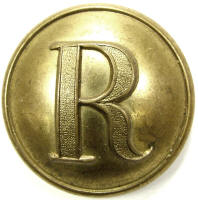
|
The Civil War Relicman, |
|
Winchester, Virginia
USA (changed hands 70 times in the Civil War!). |
|
|
relicman.com. |
Ridgeway Reference Archive, Civil War relics.
Insignia, officer epaulets.

|
The Civil War Relicman, |
|
Winchester, Virginia
USA (changed hands 70 times in the Civil War!). |
|
|
relicman.com. |
Ridgeway Reference Archive, Civil War relics.
Insignia, officer epaulets.
This is the "Ridgeway Reference Archive", a research tool for educational
purposes only, and is provided at no cost to the reader. Some of the
relics listed are retained in the author's collection, most reside in other
collections and are not owned by the author. None of the items listed in
this section are for sale, please refer to relicman.com sales listings for items
offered for sale. This is a work in progress, I list items as I get to
them, there are many patterns that are not listed yet, this list will be
regularly updated as I get pictures and descriptions for more items. I
will also correct mistakes, so if you see any please tell me.
All items listed are
believed to be original and authentic
to the Civil War or as otherwise described.
Any excavated relics have been recovered from private property with owners
permission.
Any artillery or ordnance relics have been
disarmed and rendered safe.
Any weapons are pre 1898 antique weapons,
and are exempt from Federal regulation, no licenses or permits are required.
This information is
available for research purposes, pictures may be used by permission only.
US
Regulation 1851 Epaulets (dress) for Major of Infantry.
The US 1851 Regulations gave Field Grade Officers epaulets made of gold lace
with a solid gilded brass crescent, rigid strap topped by a small gilded button,
and 'dead and bright' gold bullion fringe. The 1851 Regulations specified that
epaulets for majors do NOT include a badge of rank, they had gold bullion with a
diameter of 0.5 inches as found on this pair (as opposed to the 2nd Lieutenant
epaulets with no badge of rank and bullion with a diameter of only 0.125 inches
and a full inch shorter) This pair is complete, with a complete set of left and
right stamped mounting hard ware, retaining gilding and gold wash on all
components. The round regimental device dyed "infantry blue", an unstable
pigment that is commonly oxidizes to a faded tan to gray color.
Reference: F.P. Todd, Company of Military
Historians: Amer Military Equipage 1851-1872; Vol.. I, page 98.
M0750
US
Regulation 1851 Epaulets (Dress) for Major of Infantry. 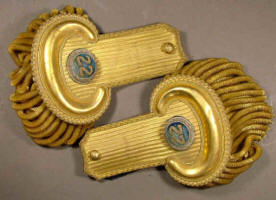
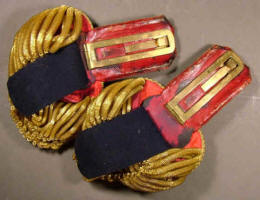
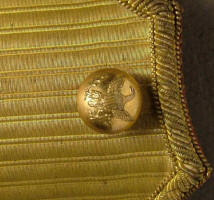
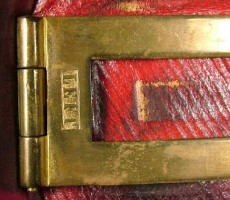
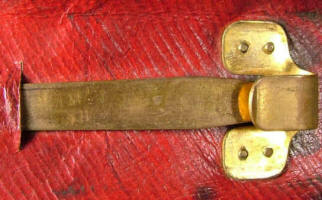
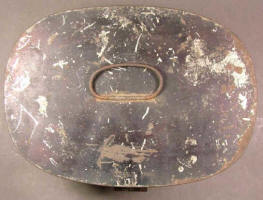
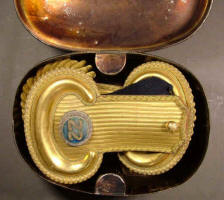

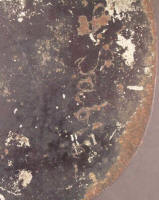 The US 1851 Regulations gave Field Grade Officers epaulets
made of gold lace with a solid gilded brass crescent, rigid strap topped by a
small gilded button, and 'dead and bright' gold bullion fringe. The 1851
Regulations specified that epaulets for majors do NOT include a badge of rank,
they had gold bullion with a diameter of 0.5 inches as found on this pair (as
opposed to the 2nd Lieutenant epaulets with no badge of rank and bullion with a
diameter of only 0.125 inches and a full inch shorter) This pair is complete,
with a complete set of left and right stamped mounting hard ware, retaining
gilding and gold wash on all components. The round regimental device dyed
"infantry blue", an unstable pigment that is commonly oxidizes to a
faded tan to gray color. The device in this pair retains a great deal of blue
color. The case is original , and despite the wear in its "japanned"
finish still bears the owners name: "D. Sabin". Both epaulets have a
large rectangular shaped piece of dark blue cloth sewn to the underside, which
can be easily removed. But, this has the appearance of old cloth and could have
been cut from the original uniform.
The US 1851 Regulations gave Field Grade Officers epaulets
made of gold lace with a solid gilded brass crescent, rigid strap topped by a
small gilded button, and 'dead and bright' gold bullion fringe. The 1851
Regulations specified that epaulets for majors do NOT include a badge of rank,
they had gold bullion with a diameter of 0.5 inches as found on this pair (as
opposed to the 2nd Lieutenant epaulets with no badge of rank and bullion with a
diameter of only 0.125 inches and a full inch shorter) This pair is complete,
with a complete set of left and right stamped mounting hard ware, retaining
gilding and gold wash on all components. The round regimental device dyed
"infantry blue", an unstable pigment that is commonly oxidizes to a
faded tan to gray color. The device in this pair retains a great deal of blue
color. The case is original , and despite the wear in its "japanned"
finish still bears the owners name: "D. Sabin". Both epaulets have a
large rectangular shaped piece of dark blue cloth sewn to the underside, which
can be easily removed. But, this has the appearance of old cloth and could have
been cut from the original uniform. Reference: F.P. Todd, Company of Military Historians: Amer Military Equipage 1851-1872; Vol.. I, page 98. |
|
M0985
Officers shoulder boards. |